Five animal tests that should no longer be taking place
We have created the RAT (Replace Animal Tests) List to highlight five animal tests which already have an accepted non-animal replacement method and yet are STILL being conducted in the UK.
Stopping these five tests it could save at least 80,000 animals every year in the UK alone.
Over the last 30 years there have been great developments in the replacement of regulatory tests – standardised tests designed to see if medicines, chemicals and other products are safe and effective – on animals. Non-animal methods have been developed that can now replace wholly, or in part, a number of animal tests across several product sectors.
However, our experience has been that these methods can take much longer to replace animal testing than most people think. In recent years, alternatives to animal tests such as skin irritation, skin sensitisation and various batch safety tests have taken years to be completely accepted and, in many cases, the animal test is still being conducted.
Since non-animal methods are usually cheaper, faster and more accurate than the animal tests they replace, it is in the interests of animal welfare and good science to speed up the process, overcome these hurdles and replace these animal tests as a matter of urgency.
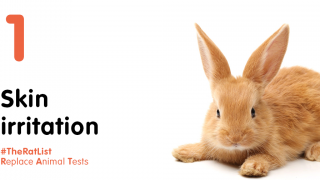
Species: Rabbits
Number of tests in the UK: 18
Product test is used for: Medical devices
Animal method: A test substance is applied to a 6 cm area of a rabbit’s shaved skin and held in place with a bandage for four hours. The rabbit is then examined for signs of skin damage for 14 days. If there are no signs of irritation, two more rabbits are used in a confirmatory test. Rabbits are singly housed and can suffer from painful skin reactions and rashes.
Replacement method: Reconstituted human skin models can be used to predict skin irritation in humans with more accuracy than the rabbit test.
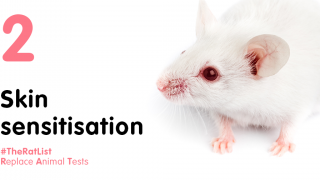
Species: Mice
Number of tests in the UK: 357
Product test is used for: Chemicals, food and food contact materials
Animal method: A substance is applied to the ears of mice every day for three days. The mice are then killed three days later, and their ears are dissected.
Replacement method: Several chemical-, computer- and cell-based tests can be used in combinations known as “defined approaches”, formalised in a guideline in 2021. These tests include the direct peptide reactivity assay (DPRA), which measures the binding of a substance to proteins, the keratinocyte assay and the human Cell Line Activation Test (h-CLAT) based on human immune cells.
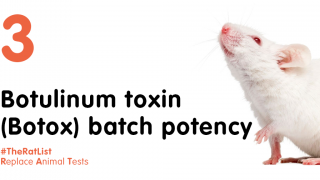
Species: Mice
Number of tests in the UK: 56,804*
Product test is used for: Human medicines
Animal method: Mice are injected into their abdomens with botulinum toxin and, over the following three days, become increasingly paralysed. Without intervention, mice in the higher dose groups stop being able to breathe and suffocate to death. Approximately 50% of the mice die per test, and survivors are killed at the end of the test.
Replacement method: The major Botox manufacturers have developed a cell-based test to replace the animal batch test for their products.
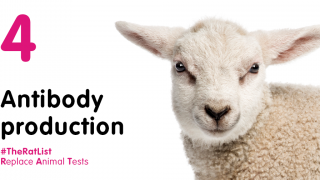
Species: Mice, rabbits, sheep, goats and others
Number of tests in the UK: 27,263*
Product test is used for: many areas of research and testing
Animal method: Animals are injected with a substance that stimulates the immune system to produce specific antibodies before their blood, spleen cells or abdominal fluid are taken to harvest the desired antibodies. The animals often suffer from harmful side effects and are killed when they are no longer useful.
Replacement method: Phage display technology – awarded the 2018 Nobel Prize in Chemistry and endorsed in 2020 by the EU Reference Laboratory for alternatives to animal testing – can be used to produce a wide range of antibodies that are better quality and more stable, relevant and consistent than those produced in animals. They can also be much faster and cheaper to produce.
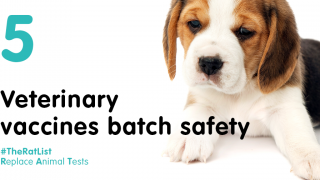
Species: Unknown (awaiting a report from the Veterinary Medicines Directorate)
Number of tests in the UK: Unknown (awaiting a report from the Veterinary Medicines Directorate)
Product test is used for: Veterinary medicines
Animal method: In the target and laboratory animal batch safety tests, animals are injected with two doses of an inactivated vaccine, or ten doses of a live vaccine, and then observed for at least two weeks. Animals can suffer painful reactions on the rare occasion the batch is contaminated, and as a result of large injection volumes relative to the animal’s size (young animals are often used).
Replacement method: Improvements in the manufacturing process of vaccines and post-market surveillance have made animal batch tests redundant. A battery of analytical tools (e.g. spectroscopy, chromatography) and cell-based tests (e.g. tests that measure the production of white blood cells and cytokines) help to establish a “product profile” for each batch of vaccine, which is then used as part of a “consistency approach” to ensure that each vaccine batch is consistent with previously tested batches.
Notes: Numbers are the number of tests (not animals), directly taken from the official GB statistics for the year 2021 unless followed by * which indicates that the calculation is available upon request.
